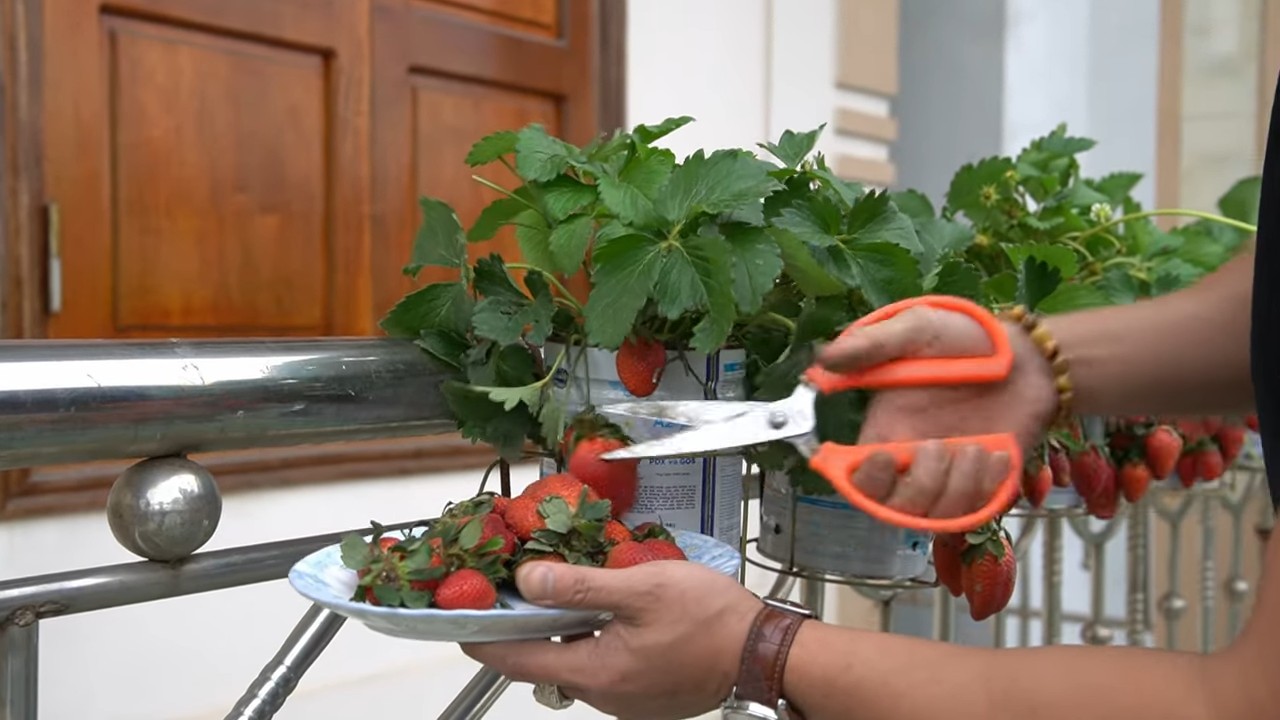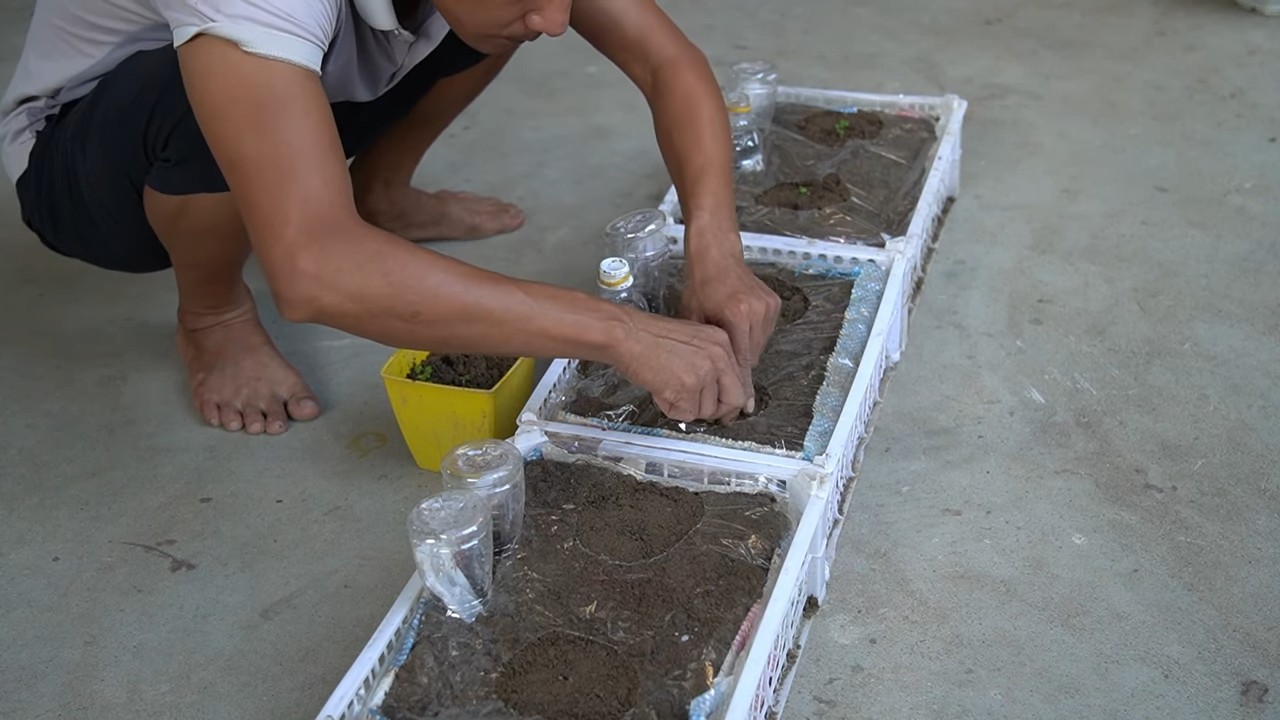Balcony strawberry growing can seem like a distant dream if you’re living in an apartment or have limited outdoor space. But guess what? It’s totally achievable, and I’m here to show you how! Forget those expensive, store-bought berries that lack that fresh-picked flavor. Imagine stepping onto your balcony and plucking juicy, sun-ripened strawberries whenever you crave them.
Strawberries have a rich history, dating back to ancient Rome, where they were prized for their medicinal properties. Over time, they’ve become a symbol of summer and a beloved ingredient in countless desserts. But you don’t need a sprawling farm to enjoy them.
In today’s busy world, finding moments of connection with nature is more important than ever. Balcony strawberry growing offers a therapeutic escape, allowing you to nurture something beautiful and delicious right outside your door. Plus, it’s a fantastic way to reduce your carbon footprint and enjoy organic produce without breaking the bank. This DIY guide will provide you with simple, effective tricks and hacks to transform your balcony into a thriving strawberry patch, even if you’re a complete beginner. Let’s get started and unlock the secrets to a bountiful balcony harvest!

DIY Balcony Strawberry Paradise: A Step-by-Step Guide
Hey there, fellow balcony gardeners! Dreaming of fresh, juicy strawberries right outside your door? Me too! And guess what? It’s totally achievable, even if you’re short on space. I’m going to walk you through creating your very own strawberry haven on your balcony. Get ready for a summer filled with delicious, homegrown goodness!
Choosing Your Strawberry Varieties
Before we dive into the nitty-gritty, let’s talk strawberries. Not all varieties are created equal, especially when it comes to container gardening. Here’s a breakdown to help you pick the perfect plants:
* June-Bearing Strawberries: These guys produce one big crop of strawberries, usually in, you guessed it, June! They’re great if you want a large harvest all at once for jam-making or freezing. However, they won’t give you a continuous supply throughout the season.
* Everbearing Strawberries: Don’t let the name fool you; they don’t bear fruit *forever*. But they do produce two or three crops throughout the spring, summer, and fall. They’re a fantastic choice for a continuous supply of strawberries.
* Day-Neutral Strawberries: These are the workhorses of the strawberry world! They produce fruit consistently throughout the growing season, regardless of the day length. They’re perfect for balcony gardens where you want a steady supply of berries.
My Recommendation: For a balcony garden, I highly recommend everbearing or day-neutral varieties. You’ll get a much longer harvest period, which means more strawberries for you! Some popular and reliable choices include:
* Everbearing: “Seascape,” “Albion,” “Ozark Beauty”
* Day-Neutral: “Tristar,” “Tribute”
Gathering Your Supplies
Okay, now for the fun part – shopping! Here’s what you’ll need to get started:
* Strawberry Plants: Obviously! You can buy bare-root plants or established plants in small pots. I usually opt for established plants because they give me a head start.
* Containers: This is where you can get creative! You can use hanging baskets, window boxes, stacked planters, or even repurposed containers like old buckets or crates. Just make sure they have drainage holes!
* Size Matters: Each strawberry plant needs at least 6-8 inches of space to grow. So, choose your containers accordingly.
* Potting Mix: Don’t use garden soil! It’s too heavy and doesn’t drain well in containers. Opt for a high-quality potting mix specifically designed for containers.
* Slow-Release Fertilizer: Strawberries are heavy feeders, so a slow-release fertilizer will provide them with a steady supply of nutrients throughout the growing season. Look for one specifically formulated for fruits and vegetables.
* Watering Can or Hose: You’ll need a way to water your plants regularly. A watering can with a gentle rose head is ideal for preventing soil erosion.
* Mulch: Mulch helps retain moisture, suppress weeds, and keep the berries clean. Straw (of course!), pine needles, or wood chips are all good options.
* Gardening Gloves: Protect your hands!
* Trowel: For planting.
* Optional: Bird Netting: If you have a lot of birds in your area, you might want to invest in some bird netting to protect your precious berries.
Planting Your Strawberry Plants
Alright, let’s get our hands dirty! Here’s how to plant your strawberry plants:
1. Prepare Your Containers: Fill your containers with potting mix, leaving about an inch or two of space at the top.
2. Planting Depth: This is crucial! The crown of the strawberry plant (the point where the stems meet the roots) should be level with the soil surface. Planting it too deep can cause the plant to rot, and planting it too shallow can dry out the roots.
3. Spacing: Space your plants according to the size of your container. As a general rule, give each plant at least 6-8 inches of space.
4. Gently Remove Plants: Gently remove the strawberry plants from their nursery pots, being careful not to damage the roots. If the roots are tightly bound, gently loosen them with your fingers.
5. Planting Time: Dig a hole in the potting mix that’s large enough to accommodate the root ball. Place the plant in the hole, making sure the crown is at the correct depth.
6. Fill and Water: Fill in the hole with potting mix, gently firming the soil around the plant. Water thoroughly until the water drains out of the bottom of the container.
7. Mulch Time: Add a layer of mulch around the plants, being careful not to cover the crown.
Caring for Your Strawberry Plants
Now that your strawberry plants are planted, it’s time to give them the TLC they need to thrive.
1. Watering: Strawberries need consistent moisture, especially when they’re fruiting. Water deeply whenever the top inch of soil feels dry to the touch. Avoid overwatering, as this can lead to root rot.
2. Fertilizing: Apply a slow-release fertilizer according to the package directions. You can also supplement with a liquid fertilizer every few weeks during the growing season.
3. Sunlight: Strawberries need at least 6-8 hours of sunlight per day to produce a good crop of berries. Place your containers in a sunny spot on your balcony.
4. Pruning: Remove any dead or yellowing leaves to keep your plants healthy. You can also prune off runners (the long stems that the plants send out) to encourage the plants to focus their energy on producing fruit. Unless you want to propagate more plants, then let the runners grow and root.
5. Pest Control: Keep an eye out for pests like aphids, slugs, and snails. You can control these pests with organic methods like hand-picking, insecticidal soap, or diatomaceous earth.
6. Protecting from Birds: Birds love strawberries just as much as we do! If you’re having trouble with birds, cover your plants with bird netting.
7. Winter Care: In colder climates, you’ll need to protect your strawberry plants from freezing temperatures. You can move the containers to a sheltered location, such as a garage or shed, or you can wrap the containers in burlap or bubble wrap.
Harvesting Your Strawberries
The moment we’ve all been waiting for! Here’s how to harvest your strawberries:
1. Ripeness Check: Strawberries are ready to harvest when they’re fully red and slightly soft to the touch.
2. Gentle Picking: Gently grasp the strawberry near the stem and twist it off the plant.
3. Harvest Regularly: Harvest your strawberries regularly to encourage the plants to produce more fruit.
4. Enjoy! Wash your strawberries and enjoy them fresh, or use them in your favorite recipes.
Troubleshooting Common Problems
Even with the best care, you might encounter some problems along the way. Here are a few common issues and how to fix them:
* Yellowing Leaves: This could be a sign of overwatering, underwatering, or nutrient deficiency. Check the soil moisture and adjust your watering accordingly. You may also need to fertilize your plants.
* Small Berries: This could be due to lack of sunlight, insufficient watering, or nutrient deficiency. Make sure your plants are getting enough sunlight and water, and fertilize them regularly.
* No Berries: This could be due to a number of factors, including lack of sunlight, poor pollination, or cold temperatures. Make sure your plants are getting enough sunlight and protect them from frost. You can also try hand-pollinating the flowers with a small brush.
* Rotting Berries: This is usually caused by overwatering or poor drainage. Make sure your containers have drainage holes and avoid overwatering. You can also try mulching around the plants to keep the berries off the soil.
Creative Container Ideas
Want to get a little more creative with your strawberry containers? Here are a few ideas:
* Hanging Baskets: Hanging baskets are a great way to save space and add visual interest to your balcony. Choose a basket that’s at least 12 inches in diameter and line it with coconut coir or sphagnum moss to help retain moisture.
* Window Boxes: Window boxes are perfect for growing strawberries right outside your window. Choose a box that’s at least 8 inches deep and wide.
* Stacked Planters: Stacked planters are a fun and unique way to grow strawberries. You can buy pre-made stacked planters or create your own using terracotta pots.
* Repurposed Containers: Get creative and repurpose old containers like buckets, crates, or even old tires. Just make sure they have drainage holes!
*

Conclusion
So, there you have it! Transforming your balcony into a thriving strawberry patch is not only achievable but also incredibly rewarding. We’ve explored a simple yet effective DIY trick that bypasses the need for extensive gardening knowledge or a sprawling backyard. This method, focusing on maximizing space and utilizing readily available materials, opens up the joy of fresh, homegrown strawberries to anyone, regardless of their living situation.
Why is this DIY balcony strawberry growing trick a must-try? Because it offers a multitude of benefits. Firstly, it’s incredibly space-efficient. Balconies, often underutilized, become vibrant, productive areas. Secondly, it’s cost-effective. You’re repurposing materials and avoiding expensive gardening setups. Thirdly, it’s incredibly satisfying. There’s nothing quite like the taste of a strawberry you’ve nurtured from seedling to ripe, juicy fruit. And finally, it’s a fantastic way to connect with nature, even in the heart of the city.
But the beauty of this DIY approach lies in its adaptability. Feel free to experiment with different container sizes and shapes. Hanging baskets can add a vertical dimension, while repurposed plastic bottles or even old tires can be transformed into unique planters. Consider companion planting – basil, thyme, or marigolds can deter pests and enhance the flavor of your strawberries. You can also explore different strawberry varieties. Everbearing strawberries will provide fruit throughout the growing season, while June-bearing varieties offer a concentrated harvest. Try alpine strawberries for a smaller, intensely flavored fruit.
Don’t be afraid to get creative with your setup. A simple trellis can support runners and keep your plants tidy. A layer of mulch, such as straw or wood chips, will help retain moisture and suppress weeds. And remember, consistent watering and fertilization are key to a bountiful harvest.
We’ve provided you with the foundation, now it’s time to personalize it and make it your own. This DIY balcony strawberry growing project is more than just a gardening endeavor; it’s an opportunity to learn, experiment, and connect with the natural world.
We wholeheartedly encourage you to give this DIY trick a try. Imagine stepping onto your balcony and plucking a sun-ripened strawberry, still warm from the sun. It’s a simple pleasure that’s within everyone’s reach.
Once you’ve embarked on your balcony strawberry growing adventure, we’d love to hear about your experience! Share your photos, tips, and challenges in the comments below. Let’s create a community of balcony gardeners, sharing our knowledge and inspiring others to embrace the joy of homegrown strawberries. Your insights could be invaluable to someone just starting out. So, grab your containers, your soil, and your strawberry plants, and get ready to transform your balcony into a strawberry paradise! Happy growing!
Frequently Asked Questions (FAQ)
What kind of soil is best for growing strawberries in containers on a balcony?
Strawberries thrive in well-draining, slightly acidic soil. A good potting mix specifically formulated for containers is ideal. Look for a mix that contains peat moss, perlite, and vermiculite. These components help retain moisture while ensuring adequate drainage, preventing root rot. Avoid using garden soil, as it can become compacted in containers and hinder root growth. You can also amend your potting mix with compost or aged manure to provide additional nutrients. A soil pH between 5.5 and 6.5 is optimal for strawberry growth. You can test your soil pH using a home testing kit and adjust it accordingly with lime (to raise pH) or sulfur (to lower pH).
How often should I water my balcony strawberries?
Watering frequency depends on several factors, including the weather, the size of your containers, and the type of soil you’re using. Generally, strawberries need consistent moisture, especially during flowering and fruiting. Check the soil moisture regularly by sticking your finger about an inch into the soil. If it feels dry, it’s time to water. Water deeply until water drains out of the bottom of the container. Avoid overwatering, as this can lead to root rot. During hot, sunny weather, you may need to water daily. In cooler, cloudy weather, you may only need to water every few days. Consider using a self-watering container or adding a layer of mulch to help retain moisture.
What kind of sunlight do strawberries need on a balcony?
Strawberries need at least 6-8 hours of direct sunlight per day to produce a good crop of fruit. Choose a location on your balcony that receives ample sunlight. If your balcony doesn’t get enough direct sunlight, you may need to supplement with grow lights. Rotate your containers regularly to ensure that all sides of the plants receive adequate sunlight. If you live in a particularly hot climate, you may need to provide some afternoon shade to protect your plants from scorching. A shade cloth can be used to filter the sunlight during the hottest part of the day.
How do I fertilize my balcony strawberry plants?
Strawberries are heavy feeders and benefit from regular fertilization. Use a balanced fertilizer specifically formulated for strawberries or fruits and vegetables. Follow the instructions on the fertilizer package carefully. Avoid over-fertilizing, as this can burn the roots of your plants. You can also use organic fertilizers, such as compost tea or fish emulsion. Fertilize your plants every 2-4 weeks during the growing season. Stop fertilizing in the late fall to allow your plants to harden off for the winter.
How do I protect my balcony strawberries from pests and diseases?
Strawberries are susceptible to a variety of pests and diseases. Common pests include aphids, spider mites, and slugs. Common diseases include powdery mildew and gray mold. Inspect your plants regularly for signs of pests or diseases. Remove any affected leaves or fruit immediately. You can use insecticidal soap or neem oil to control pests. For diseases, use a fungicide specifically formulated for strawberries. Good air circulation can help prevent fungal diseases. Avoid overcrowding your plants and water them in the morning so that the foliage has time to dry before nightfall. Consider using companion planting to deter pests. Basil, thyme, and marigolds are all good companions for strawberries.
Can I grow strawberries on my balcony year-round?
Whether you can grow strawberries year-round on your balcony depends on your climate. In mild climates, you may be able to grow strawberries year-round. In colder climates, you will need to protect your plants from freezing temperatures. You can move your containers indoors during the winter or cover them with a layer of mulch or straw. Some strawberry varieties are more cold-hardy than others. Check the hardiness zone for your chosen variety to ensure that it is suitable for your climate.
How do I propagate my balcony strawberry plants?
Strawberries produce runners, which are horizontal stems that grow along the ground and produce new plants. You can propagate your strawberry plants by rooting these runners. Simply place a small pot filled with potting mix near the mother plant and secure the runner to the soil with a paperclip or hairpin. Once the runner has developed roots, you can cut it from the mother plant and transplant it to a new container. This is a great way to expand your strawberry patch without having to buy new plants.
What are the best strawberry varieties for balcony growing?
Several strawberry varieties are well-suited for container growing on balconies. Everbearing varieties, such as Albion, Seascape, and Ozark Beauty, produce fruit throughout the growing season. June-bearing varieties, such as Chandler and Honeoye, produce a concentrated harvest in the spring. Alpine strawberries, such as Alexandria and Yellow Wonder, are smaller plants that produce small, intensely flavored fruit. Choose a variety that is well-suited for your climate and growing conditions. Consider the size of the plant, the flavor of the fruit, and the length of the harvest season when making your selection.




Leave a Comment